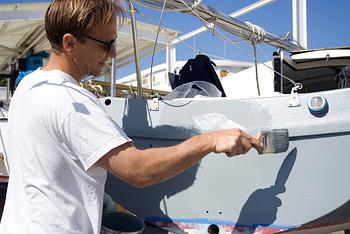It’s often said that a bad day on the water is better than a good day in the office, but what about the days when your boat is out of the water and needs a little work? Some jobs can be stressful, some can be costly, but there are a few ways to bring the sparkle back to your sailing without too much stress and bother.
DIY boat maintenance can be a daunting thought. Whether it’s wood or fibreglass, sail or motor, there are all kinds of jobs that get handed over to the experts which even a new boat owner could do themselves. Though some things are best left to professionals, the more you feel confident in doing yourself the cheaper maintaining your boat becomes – so here are a few suggestions.
Stain prevention and removal
It goes without saying that the better your stain prevention efforts, the less time you’ll have to spend removing stains. Staining on fibreglass boats can be caused by anything from vegetation in the water to spilled wine on deck, while staining on wooden boats may also be a likely result of weathering and mould. Sanding and re-varnishing will usually solve stains on wood, though in some instances you may need to use oxalic acid to really lift the darker patches.
On fibreglass, it’s maintaining the overlying gelcoat that will keep your boat looking fresh and clean. Though it can be awkward while a boat is in the water, cleaning off obvious stains after every sailing will stop them from settling in. Avoid heavy-duty cleaners where you can – simple boat soap and water are less likely to do unnecessary damage during DIY cleaning, and you can move on to the serious chemicals later if needed.
Once you’ve buffed out stains, you need to rewax the gelcoat. Rather than doing this once in a blue moon and leaving it to somebody else, try to make it a small, regular job for yourself. A traditional carnauba wax is often enough on gelcoat that’s in good shape, but a polymer sealant or hybrid wax is a worthwhile investment if you think you need something a little heavier duty.
Lastly, be sure to wash your fibreglass down after sailing in saltwater boats. Even if nothing looks dirty, when saltwater dries it leaves crystals behind that can magnify UV and speed up the breakdown of your wax.
Interior cleaning and vinyl protectant
Though reupholstering is a job for those who are properly trained, maintaining your upholstery and other interior detailing needn’t be an added expense. Marine upholstery is designed to withstand moisture and direct sunlight, but without a helping hand it can still wear out sooner than expected.
At home, most of us don’t question the fact that cleaning and simple repairs are something we can do ourselves, but for some reason when it comes to sailing, the fear of managing to damage an asset can get in the way of even the easiest tasks. It goes without saying that vacuuming and polishing are going to keep your interiors looking good, but don’t be afraid to use vinyl protectant and hydrogen peroxide washes too.
One part hydrogen peroxide to one part water gives you an instant cleaning spray ideal for scrubbing seats and seams, which is invaluable in protecting against and removing any mould or mildew that tries to strike. Avoid the temptation to use standard household cleaning products that may not be suited to the purpose. Bleach and ammonia will damage fabrics and vinyl, and are best left well away.
As with proper cleaning, vinyl protectant can help to slow and prevent damage from damp and excessive sunshine, extending the life of interior vinyl between replacements. Check for rips, cracks and tears when you’re applying protectant, as these can let salt and water in and lead to serious mould and rot.
If you’re storing your boat for the winter, remove any fabric or leather covers that are prone to mould and mildew and store them elsewhere.
Removing barnacles and covering
As well as washing down your boat after saltwater sailing, be sure to give it a thorough hose down each time it comes out of the water completely – and keep an eye out for barnacles while you’re at it.
While cleaning and covering are crucial when winterizing a vessel, it’s important to remember them throughout the year to extend the life of your boat. Barnacles, in particular, can be very damaging, and removing them is nobody’s favourite task. To get these stubborn creatures off, you’ll need to use a paint scraper, or in some cases, a pressure washer, and your boat will need to be out of the water.
As you can imagine, scraping barnacles off isn’t great for your boat’s exterior. Dull the edges of any scraper before you start to minimize the risk of scratches, and use a stainless steel mesh to remove finer parts left behind once most of the barnacles have been knocked off. You’ll also need to wash the affected area down with a lime wash once you’re done, and re-apply antifouling paint and any protective waxes you’ve removed. Antifouling paint can prevent barnacles from attaching themselves to your hull in future, something anyone will be glad off after their first session of barnacle removal.
Once your boat is clean and barnacle-free, be sure to keep it covered. Wooden boats are particularly susceptible to damp rot and other weather damage, but fibreglass can also suffer when left exposed to the elements. As a general rule, wood suffers the most in winter, and fibreglass suffer in summer. Whatever your boat of choice, a protective cover is a simple way to stop damage from occurring and takes no time at all to put on yourself.
Leave it to the experts
Just as there are tasks that are avoided even though they’re easy to do, there are tasks that people attempt to do themselves that can end up doing serious damage. Fibreglass repairs often seem like a small job – a scratch here, a dent there. But you’ll need to invest in some serious kit to do fibreglass repairs properly, from professional standard buffers to die grinders and rotary tools. Rather than patch fibreglass damage yourself and risk a bigger problem later, this is a task where it’s best to get help.
Likewise, cleaning and re-coating sails can seem like a straightforward job but do it wrong and you’re looking at an expensive mistake. Sail materials don’t like being creased or left out in the wind, so scrunching them up in a bathtub or hosing and hanging out to dry in the air are no-gos.
Badly cleaned sails are also liable to lose their protective coating, leaving you wide open to mould and mildew that rots the fabric and lands you in need of a whole new set of sails. If a job bigger than simple rinsing needs doing, professional cleaning and surface coat reapplication is a worthwhile investment and leave you plenty of time for all the jobs that you can safely do yourself.
Related Articles and Guides
29th Mar 2024
How to Transport Your Boat Four Different Ways
18th Oct 2023
How to Winterize a Boat: Steps, Checklist and Costs
20th Sep 2023
Painting a Fiberglass Boat: A Detailed Guide
19th Sep 2023






